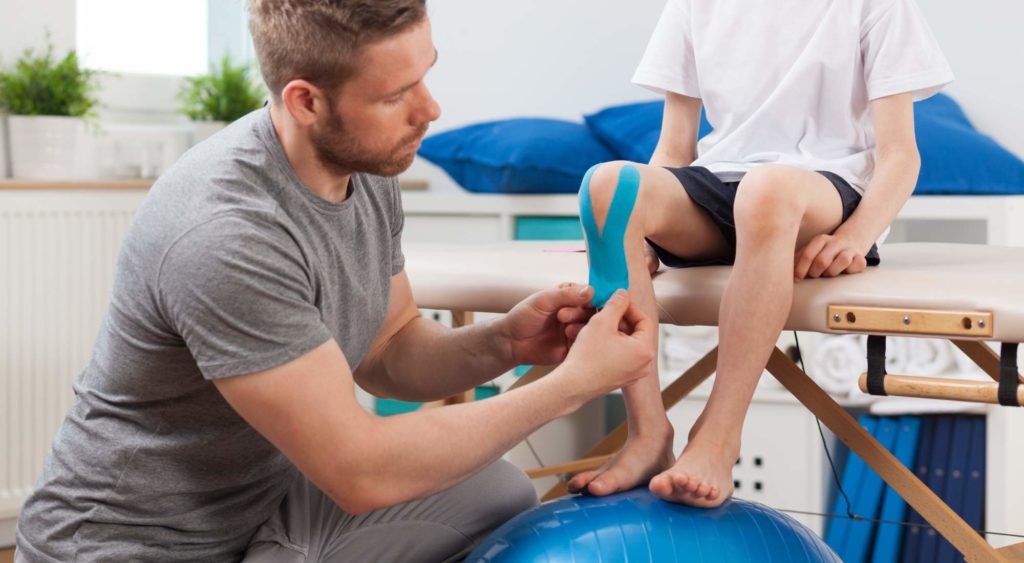
You have been experiencing pain. At first, it was mild but over time it has grown more intense.
Some of your friends have suggested physical therapy, but what is physical therapy used for?
You can let physical therapy help with your ailment.
In this informative guide, we will discuss everything you need to know about physical therapy as a treatment for common ailments and we’ll help you determine if physical therapy can help.
Table of Contents
- What Conditions Do Physical Therapists Treat?
- Will Physical Therapy Help? 15 Ways Physical Therapy Can Help
- Does Physical Therapy Help? Find Out At In Motion O.C.

What Conditions Do Physical Therapists Treat?
Physical therapists treat many conditions including:
- Recovery from stroke or paralysis
- Fall prevention
- Improved balance
- Management of age-related medical problems
- Lymphedema
- Muscular dystrophy
- Back and neck pain
- Limited range of motion (ROM)
- Osteoporosis
- Vertigo
- Headaches
If you’re suffering from any of these conditions, physical therapy might be the relief you’ve been searching for. In Motion O.C.’s #1 rated physical therapists can give you hope and help as you work toward a pain-free future.
Will Physical Therapy Help? 15 Ways Physical Therapy Can Help
The big question you have is, “Will physical therapy help treat my ailment?” You’re skeptical because you have tried so many things with no relief. You have tried creams and prescriptions, but the pain always seems to come back.
Before you commit to another treatment, you want to know will physical therapy help and is it worth it?
Keep reading to learn how physical therapy can help you.
#1: Reduce Pain
Pain is debilitating. It steals away pieces of you. Pain can take away those small pleasures you used to enjoy like walking on a nature trail or simply walking down a grocery aisle.
You may be experiencing chronic pain due to aging. This usually occurs in the joints or bones and always seems to get worse as the weather grows colder.
Chronic pain can also be a result of nerve damage or an injury that did not heal properly.
Did your pain come on suddenly? Did it wake you from sleep or interrupt dinner? When the pain hit, it was swift and severe. This is acute pain. It can be an indicator of something more serious or a result of an injury.
Whether you are suffering from chronic or acute pain, you wonder will physical therapy help reduce your pain.
In some cases, acute pain is a result of a pinched nerve, so reducing that strain and restoring fluid movement will help alleviate the pain. This can be accomplished by a physical therapist.
Physical therapy can also treat chronic pain by strengthening and stretching muscles to help alleviate painful symptoms.

#2: Avoid Surgery
Surgery is scary — the anesthesia, the scars, and the hefty medical bills. And you worry after all of that, “What if it doesn’t work?”
You may believe surgery is your only option when dealing with an injury or pain.
But there may be an alternative.
Specialized techniques performed by a licensed physical therapist can help prevent invasive procedures.
Early physical therapy interventions have been linked to reducing costs related to surgery as well as preventing the recurrence of similar symptoms.
Using physical therapy to avoid surgery could be a good option for you, but you wonder if physical therapy will hurt. The short answer is no, physical therapy should not hurt.
It is challenging. It can cause soreness and discomfort, but when performed by a licensed physical therapist it can also prevent costly surgeries and help you get back to your life.
#3: Prevent Injuries
The best offensive is a good defensive. The best way to prevent injuries is to ensure your body’s joints and muscles are strong.
In Motion O.C. has a built-in fitness coaching business that allows physical therapists and fitness coaches to communicate, ensuring their patients can reach their physical goals without causing any harm or pain.
They work together to develop programs designed to:
- Improve posture
- Balance
- Flexibility
- Cardiovascular endurance
- Overall function
These programs are focused to prevent the recurrence of pain and injury.
#4: Improve Mobility and Balance
Are mobility and balance a challenge for you? Have you experienced falls due to a lack of balance? Has your mobility been reduced due to chronic pain or injury?
Balance and mobility involve the distribution of weight and coordination of the muscles, bones, and joints. Your mobility and balance may be affected by a medical condition such as a stroke or weakness in limbs.
If you are experiencing problems with your balance or mobility, you may wonder will physical therapy help?
Physical therapists specialize in mobility and can help you reap the benefits of an active lifestyle with techniques and treatments such as:
- Soft and deep tissue massage
- Joint mobilization
- Aquatic therapy
- Pilates
- Postural exercises
- Kinesio taping
- Electrical stimulation
- Stretching
- Therapeutic exercises
- Education
- Home exercise programs
#5: Manage Age-Related Issues
Let’s face it, none of us are getting any younger. The benefit of aging is that we gain wisdom, but it often comes with stiff muscles, joint pain, and limited range of motion.
Age is just a number and there are ways to slow down the effects of the aging process within our bodies.
Does physical therapy help to manage age-related issues?
Yes, it does.
The effects of age-related conditions such as arthritis and osteoporosis can be greatly reduced by working with a physical therapist to slow down the effects of these conditions.

#6: Improve Athletic Performance
As an athlete, you are always looking for ways to improve performance. You eat foods to fuel your body, use assessment tools to measure progress, and spend all your free time working out.
You may wonder if you have time for physical therapy and whether physical therapy will improve your athletic performance.
In Motion O.C. has certified fitness coaches who will develop a plan to help you reach your peak performance, whether it is completing a 5k or attending Olympic Trials.
Our physical therapists are here to support our fitness coaches to ensure all of your individual body needs are met.
#7: Reduce Medication Dependencies
Pain medication is a short-term solution to a long-term problem. Meds can provide quick relief from the pain, but that relief can come at a hefty price.
Long-term opioid usage can result in:
- Serious fractures
- Breathing problems during sleep
- Increased sensitivity to pain
- Suppression of the immune system
- Heart attack
- Chronic constipation
- Bowel obstruction
- Tooth decay
- Imbalanced hormones
- Hormone imbalance
- Erectile dysfunction
- Infertility
- Decreased libido
- Osteoporosis
- Depression
- Overdose
- Death
Some studies have shown early intervention in the form of physical therapy can prevent long-term opioid dependence.
Working with a physical therapist can help alleviate your symptoms and ailments — reducing the need for medication and without those awful side effects.
#8: Speed Up Surgery Recovery
There are times when surgery is inevitable. You have tried physical therapy, pain management, and lifestyle changes, but sometimes surgery is necessary.
After you have undergone surgery, you may wonder if physical therapy helps to speed up surgery recovery.
Yes, physical therapy can speed up surgery recovery.
Physical therapy increases blood flow which helps your vital organs (heart, lungs, and muscles) maintain a healthy state. Furthermore, regular exercise with the guidance of a fitness coach will speed up healing at the surgical site.
In addition to the physical benefits physical therapy offers after surgery, it can also boost your mental health. The more consistent your physical routine is, the faster you will get back to the life you had before surgery.
#9: Manage Diabetes
34.2 million Americans (just over 1 in 10) have diabetes. Diabetes can lead to stroke, heart disease, kidney failure, amputation, and blindness. Managing your diabetes includes more than incorporating a balanced diet and checking blood sugar.
To manage diabetes, it’s important to incorporate physical activity. A physical therapist can help keep you accountable and keep you moving.
If you have been diagnosed with diabetes, physical therapy can help:
- Increase range of motion in joints
- Reduce blood pressure and cholesterol levels
- Decrease the risk for heart disease and stroke
- Manage weight loss
- Boost energy
- Improve sleep patterns
- Relieve stress
- Improve circulation
- Improve balance
#10: Manage Heart and Lung Disease
The lungs are the filter of our bodies and the heart is the pump. These are two of the most vital organs in our bodies, so when they fail it can result in catastrophic consequences.
To improve your overall heart and lung health, you may try a change in diet or avoiding stressful situations. But have you considered physical therapy?
Heart disease is the #1 cause of death in the United States, so to prevent heart disease, you must get moving. An active lifestyle can help prevent heart and lung disease.
Physical therapy can strengthen your heart and lungs, reducing blood pressure and cholesterol while improving oxygen flow.
Cardio exercise under the guidance of a trained professional, such as a physical therapist, can reduce the risk of:
- Diabetes
- Alzheimer’s disease
- Stroke
#11: Improve Pelvic Health
Children are a blessing and while you love your newborn, you don’t love the pelvic pain and incontinence that developed after your pregnancy.
There is hope — physical therapy can reduce pain and strengthen your core muscles, improving incontinence.
In Motion O.C. has developed a women’s health program specifically designed to improve pelvic health and other symptoms unique to women.
This program includes:
- Establishing a plan of care that is individualized to you
- Various therapeutic exercises to target specific muscles
- Hands-on treatments utilizing special techniques unique to Doctors of Physical Therapy
- Modalities to help alleviate pain
- Pilates reformer exercises to help strengthen and tone core
- A customized home exercise program
#12: Improve Postpartum Recovery
Growing a tiny human is hard on your body. This is in part due to hormonal changes that cause loose ligaments and joints, which can lead to displacement or other muscle and joint injuries. In addition, weight gain can cause a shift in your center of gravity that can lead to a curve in the spine and pelvic tilting.
Does physical therapy help to improve postpartum recovery?
Physical therapy can strengthen your pelvic floor, reducing incontinence and pain. It also lowers the risk of vaginal prolapse, provides better bowel and bladder control, and can speed up postpartum recovery.
#13: Manage Chronic Pain
Chronic pain affects nearly 50 million Americans. Odds are you or someone you know is dealing with chronic pain. This is defined as a persistent pain that lasts longer than 12 weeks despite medication or treatment.
You’ve read about some of the negative side effects caused by prescription pain medications, but one survey found that these medications don’t work for everyone. In fact, only 58% of people surveyed reported that pain meds relieved their pain.
Medical conditions that lead to chronic pain include:
- Arthritis
- Lower back pain
- Neuropathy
- Multiple sclerosis
- Fibromyalgia
- Shingles
If you have been diagnosed with any of these conditions and experiencing chronic pain, physical therapy can improve posture, muscle weakness, and imbalance. A physical therapist can perform pain-reducing modalities such as traction, taping, and massage to assist with chronic pain.
Chronic pain differs from acute pain because it lasts much longer, which means the treatment will also last a bit longer.
#14: Recover From Sports Injuries
Sports injuries can be as mild as a slight muscle strain and as severe as a torn ligament or dislocated joint.
But regardless of how big or small your sports injury is, the goal is to recover quickly so you can get back in the game.
In Motion O.C.’s highly trained Doctors of Physical Therapy have designed a program for athletes that focuses on:
- Strength Deficits
- Flexibility Deficits
- Postural Deficits
- Neuromuscular Recruitment Patterns
- Mechanical / Movement Deficits (with running, jumping & cutting)
Don’t let a sports injury keep you from reaching your goals. Physical therapy can help to reduce downtime and get you back on the court.
#15: Recover From Stroke Or Neurological Conditions
If you are a loved one who has suffered a stroke or other neurological condition, you know how imperative it is to begin rehabilitation and recovery quickly.
Can physical therapy help speed up the recovery process?
Incorporating physical therapy into a rehabilitation program following a stroke or other neurological condition can vastly improve recovery and help patients regain muscle strength, mobility, and balance.
One study showed stroke patients who participated in physical therapy scored “higher on the Berg Balance Scale (used to objectively determine a patient’s ability,or inability, to safely balance) and increased independence of balance and mobility.”
Does Physical Therapy Help? Find Out At In Motion O.C.
To learn more about what is physical therapy used for and if you can benefit from it, contact In Motion O.C. — the #1 rated physical therapy clinic on Yelp! and Google.
In Motion O.C. has helped hundreds of people with different ailments through physical therapy. Contact us today to start your road to recovery.



